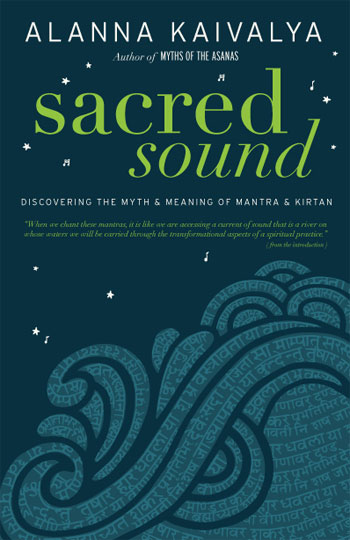Mantra and kirtan—the mystically beautiful and often mysterious pieces of yoga.
Alanna Kaivalya describes the mantra tradition as “crafted to illuminate what is alive within us: our vast potential that needs only the right key to be unlocked.” Mantra is a term often associated with meditation or intentions set during yoga practice, but their use is also an integral part of chanting and kirtan.
Kaivalya refers to chants as “focused phrases that reveal powerful human truths.”
I was introduced to chant during my early years of yoga practice. Enchanting voices singing mystical words would loft throughout the yoga studio.
One of my teachers used to chant during savasana, her voice would fill the space and call my busy mind to rest. There was one evening years ago when I showed up early to my favorite Friday evening class and had the honor of listening to Krishna Das prep for his performance at the studio across the hall. His booming voice and accompanying harmonium made the lyrics come alive.
Chant and kirtan are often associated with the path of bhakti yoga, or yoga of devotion, where the yogi expresses her reverence through mantra, chant, and prayer. Most yoga paths incorporate mantras into their practice and many traditions have chants used to open or close their practice (the Ashtanga chant Vande Gurunam is one example). The mantra most associated with yoga is the sacred chant of om.
Mantras and chants are born from sacred myths and legends and help to connect the practitioner to the spiritual side of yoga. Alanna Kaivalya explains this connection in her latest book, Sacred Sound: Discovering the Myth & Meaning of Mantra & Kirtan, stating that “as we harmonize, we create a self that is in sync with our highest vibration.”
Sacred Sound is a thoughtful look at the practice of chant and kirtan, breaking through the mystery often associated with their lyrical meanings. In her straightforward style, Kaivalya delves into the basis behind the most noted chants and kirtans.
Like her previous book, Myths of the Asanas, she explains the back story of each sound, their meanings, and the myths in which they are based—and she does so with a direct, simple approach. One of my favorite aspects of Kaivalya’s writing is her ability to convey esoteric information in a relatable way. She makes the ethereal easy to understand.
With Sacred Sound, Kaivalya explores eleven mantras and ten kirtans. She provides a Sanskrit alphabet and a Latin alphabet interpretation with each chant as well as a translation into English. Her rich descriptions of the mythical stories at the root of each mantra are intriguing. I also appreciated her “advice for chanting” included in each section. Kaivalya is an experienced mantra and chant musician and incorporates sound and kirtan as part of her teaching. She uses her own practical experiences to suggest how to make the most of each chant.
She invites the reader to “get to know these mantras. Hang out with them for a while. They are worthwhile teachers on this spiritual path. The are great aides in guiding us home.”
Being a research nerd, I couldn’t help but appreciate Kaivalya’s endnote and bibliography sections, which are a treasure trove of writings on mythology, chant, and yoga spirituality. The only thing I wish she had included were suggestions or links to actual performances, so I could hear each chant and get a better sense of its sound and vibration.
As one who is drawn to music, I’ve always wished to delve more into a sound practice, but often felt at a loss with where to start. Kaivalya’s Sacred Sound helps to bridge that gap and makes the practice more accessible in an engaging and relatable manner. It’s also comprehensible enough to be an excellent reference guide for the more experienced practitioner.
Kaivalya notes that “the spiritual practices of yoga help to shine us up like a new penny, ready to radiate peace.” Her considerate and detailed work on Sacred Sound will certainly help brighten up your own practice and become a go-to resource for chant and kirtan.
For more:
Check out our Walk the Talk Show interview with Alanna!
Check out one of Alanna’s elephant journal articles, Seven Reasons that Calling Yourself a Yoga Teacher Sucks
Love elephant and want to go steady?
Sign up for our (curated) daily and weekly newsletters!
Editor: Renée Picard












Read 0 comments and reply